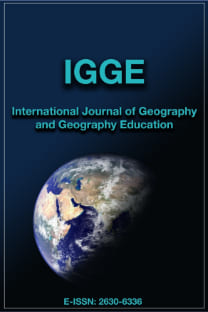CBS, GPS VE GOOGLE EARTH TEKNOLOJİLERİNİN COĞRAFYA DERSLERİNDE KULLANIMI
Bu çalışma CBS, GPS ve Google Earth teknolojilerinin birlikte kullanıldığı bir etkinliğin ortaöğretim coğrafya derslerindeki uygulanabilirliğinin test edilmesi amacı ile gerçekleştirilmiştir. Çalışma İstanbul İl Milli Eğitim Müdürlüğü ve Fatih Üniversitesi işbirliği ile İstanbul’da görev yapan coğrafya öğretmenlerine verilen CBS kursu sırasında gerçekleştirilmiştir. Çalışmaya İstanbul’daki 19 ilçede yer alan 25 farklı ortaöğretim kurumunda çalışan 25 coğrafya öğretmeni katılmıştır. Çalışmada öğretmenler öncelikle Fatih Üniversitesi İstanbul kampüsünde 18 noktadan toprak ve hava sıcaklığı ile bağıl nem gibi değerleri GPS ile konum verilerini alarak arazide ölçmüşlerdir. Öğretmenler, topladıkları verileri CBS ortamına aktararak her bir değer için dağılım haritaları üretmiş ve bunları Google Earth üzerinde göstermişlerdir. Etkinliğin değerlendirilmesi amacı ile çalışma sonrasında öğretmenler üzerinde bir anket çalışması uygulanmıştır. Anket sonuçları SPSS 17 kullanılarak ağırlıklı olarak sıklık analizleri şeklinde değerlendirilmiştir. Çalışmada CBS, GPS ve Google Earth’ün birlikte kullanılması ile gerçekleştirilen etkinliğin coğrafya dersleri için faydalı bir öğretim yöntemi olabileceği görülmüştür.
Anahtar Kelimeler:
CBS, GPS, Google Earth, Coğrafya Dersleri, Ortaöğretim
-
-
Keywords:
-,
___
- Bednarz, S.W., Schee, J., Van Der., 2006, “Europe and the United States: the implementation of geographic information systems in secondary education in two contexts” Technology, Pedagogy and Education, 15(2), 191-205.
- Bednarz, S.W., 2004, “Geographic information systems: A tool to support geography and environmental education?” GeoJournal, 60, 191-199.
- Birkin, M., Clarke, G., Cclarke, M. & Wilson, A., 1996, Intelligent GIS: Location Decisions and Strategic Planning. Cambridge: GeoInformation International.
- Beddingfield, K.T.; Bennefield, R.M.; Chetwynd, J.; Ito, T.M.; Pollack, K. & Wriht, A.R., 1995, 20 hot job tracts. U.S. News and World Report, 30 October, 98-108.
- Butler, D., 2006, “Virtual globes: the web-wide world” Nature, 439, 776778
- Johansson, T. (Ed)., 2006, GISAS project: Geographical information systems applications for Schools. Finland: University of Helsinki.
- Johansson, T., 2003, “GIS in teacher education-facilitating GIS applications in secondary school geography” ScanGIS’2003 On-linePapers, pp.285-293.
- Kerski, J. J., 2003, “The implementation and effectiveness of geographic information systems technology and methods in secondary education” Journal of Geography, 102(3), 128-137.
- Liu, Y., B., Elisabeth, N., Chang, C., H., & Lossman, H., G., 2010, “PBL-GIS in secondary geography education: Does it result in higher-order learning outcomes?” Journal of Geography, 109(4), 150-158.
- Landenberger, R.E., Warner, T.A., Ensign, T.I. & Nellis, M.D., 2006, “Using Remote Sensing and GIS to teach inquiry-based spatial thinking skills: An example using the GLOBE program's integrated Earth systems science” Geocarto International, 21:3, 61-71.
- Malone, L., Palmer, A. M., Voigt, C. L., 2003, Mapping Our World; GIS lessons for Educators, ESRI Press, USA.
- Marsh, M., Golledge, R., & Battersby., S.E., 2007, “Geospatial concept understanding and recognition in G6-college students: “A preliminary argument for minimal GIS” Annals of the Association of American Geographers, 97(4), 696-712.
- McClurg, P.A. & Buss, A., 2007, “Professional development: Teachers use of GIS to enhance student learning” Journal of Geography, 106(2), 79 -87.
- Patterson, T.C., 2007 “Google Earth as a (Not Just) geography education tool” Journal of Geography, 106(4), 145-152.
- Yomralıoğlu, T., 2000, Coğrafi Bilgi Sistemleri: Temel Kavramlar ve Uygulamalar. Seçil Ofset, İstanbul.
- Zhouh, Y., Smith, B.W. ve Spinelli, G., 1999, “Impacts of Increased Student Career Orientation on American College Geography Programmes” Journal of Geography in Higher Education, 23(2), 157-165.
- Yayın Aralığı: Yılda 3 Sayı
- Başlangıç: 1996
- Yayıncı: Marmara Üniversitesi
Sayıdaki Diğer Makaleler
KAYADELEN KARSTİK TÜNELİ (MUŞ-VARTO)
AFYONKARAHİSAR İLİNDE ALTERNATİF TARIM ÇALIŞMALARINA BİR ÖRNEK: JEOTERMAL SERACILIK
COĞRAFYA ÖĞRETİMİNDE TEKNOLOJİ KULLANIMININ ORTAÖĞRETİM ÖĞRENCİLERİNİN ALGILARINA ETKİSİ
TÜRKİYE’DE YER DEĞİŞTİREN YERLEŞMELERE BİR ÖRNEK: ARGUVAN İLÇE MERKEZİ (MALATYA)
Gülpinar AKBULUT, Gülpınar AKBULUT
NEVŞEHİR’İN İKLİM VE CANLI İKLİMİNİN TURİZM AÇISINDAN DEĞERLENDİRİLMESİ
Mehmet ÖZDEMİR, İsmail KERVANKIRAN
BEYMELEK LAGÜNÜNÜN LİMNOLOJİK VE JEOMORFOLOJİK ÖZELLİKLERİ
EVLİYA ÇELEBİYE GÖRE 17. YÜZYILDA EDİRNE’NİN ŞEHİR COĞRAFYASI VE KÜLTÜREL HAYAT
Mehmet KARAKUYU, Faruk SARIUSTA
SOSYAL BİLİMLER LİSESİ ÖĞRENCİLERİNİN ÇEVRE DUYARLILIKLARININ DEĞERLENDİRİLMESİ
